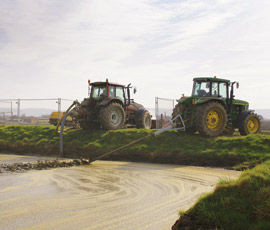Dairy farm pollution incidents increase by 38%

The severe wet weather of 2012 has been blamed for a 38% rise in serious pollution incidents on dairy farms.
Environment Agency figures show 39 serious incidents occurred in 2011 – but that figure jumped to 54 in 2012.
The rise bucks a downward trend which has seen pollution across all industries halved from 1,292 in the year 2000 to 617 in 2012, according to the agency’s annual Pollution Incidents Report.
The report adds that farming had followed this trend until 2012.
“Between 2008 and 2011, pollution incidents from agriculture also declined. However, in 2012 this trend reversed,” the report states.
Figures show the large majority of incidents came from dairy farms spreading or storing slurry.
“The prolonged wet weather in 2012 may have contributed to this increase by filling uncovered slurry stores more quickly than expected and causing structural damage or by washing slurry that had been spread on fields into rivers and streams,” the report suggests.
It also adds that agency officials are concerned about the number of slurry stores coming to the end of their design life, leading to an increased risk of structural failure.
An agency spokesman said: “We have a programme of surveys that will be completed during 2013-14, which will help us target our pollution prevention work and advice to farmers and others who use land as a means of recovering materials.”
Other areas in agriculture also showed a year-on-year increase in incidents to the end of 2012.
Poultry farms saw a rise from four incidents in 2011 to seven incidents in 2012. The arable sector recorded a rise from seven to 10 incidents over the same timespan and pig farming saw a rise from three to seven.
NFU dairy adviser Luke Ryder said: “We have been very encouraged by the progressive downward trend in pollution incidents from agriculture over the past few years, which has been down to a number of factors including the take up of advice, the implementation of good practice, and investment in storage capacity and machinery.
“Last year, 2012, was one of the wettest on record, coinciding with the reversal in the declining trend.
“The important next step will be to get a better understanding of the types of incidents that contributed to the increases in 2012, but the uptake of advice and continued investment will remain key.”
